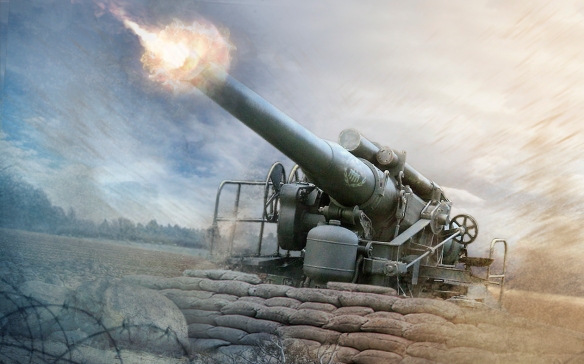The 240 mm Howitzer M1, popularly nicknamed the “Black Dragon”, was a towed howitzer used by the United States Army. The 240 mm M1 was designed to replace the World War I era 240 mm Howitzer M1918 which was based on a 1911 French design and was outdated by World War II. The project to replace the M1918 began in 1941. The 240 mm howitzer was the most powerful weapon deployed by US field artillery units during World War II, able to fire a 360 lb (160 kg) high explosive projectile 25,225 yards (23 km). It was the largest field piece used by the US Army during the war except for naval ordnance adapted into railway guns. The weapon addressed the requirement for super heavy field artillery capable of attacking heavily reinforced targets like those likely to be found along the Siegfried Line.
Because of the desire for mobility and maneuverability and because of the belief that the newly developing Army Air Corps would provide much of the support formerly furnished by the field artillery, the War Department did not place a very high priority on heavy artillery. In September 1942, the AGF recommended one hundred one battalions of heavy artillery (155-mm. and 8-inch guns and 240-mm. howitzers) and one hundred forty battalions of medium artillery (155-mm. howitzers and 4.5-inch guns) to be organized in addition to the division artillery units, but the following year, the War Department drastically reduced this number to fifty-four heavy and eighty-one medium battalions. The low number of authorized battalions made impossible the planning figure of 3.93 nondivisional field artillery battalions for each division as devised by the AGF. At no time during the war did the nondivisional field artillery battalions ever exceed the ratio of 2.89 battalions per division. From one hundred forty-two nondivisional field artillery battalions (thirty-two heavy, fifty-three medium, and fifty-seven light) active on 31 December 1942, the number expanded to three hundred twenty-six by 31 March 1945, of which one hundred thirty-seven were heavy, one hundred thirteen medium, and seventy-six light. The AGF had proposed considerable increases in heavy and medium artillery that the War Department did not accept in 1942. After combat experiences in Italy (especially Cassino in early 1944) proved that air support could not altogether replace heavy artillery, the department authorized more heavy and medium artillery than the AGF had originally requested.
The medium and heavy battalions were organized along lines similar to the division artillery battalions. Each had a headquarters and headquarters battery, a service battery, and three firing batteries. Each battalion was authorized two liaison airplanes for observation. With the exception of those in the 8-inch gun and 240-mm. howitzer battalions, each firing battery had four field artillery weapons, giving the battalion a total of twelve guns or howitzers. The 240-mm. howitzer and 8-inch gun battalions all had three firing batteries each, but the batteries had only two guns or howitzers each, for a total of six howitzers or guns in each battalion.
Nondivisional medium artillery usually served with divisions and corps in reinforcing and general-support missions. The 155-mm. howitzers were the same as those used in the division artillery, while the 4.5-inch field gun, capable of firing a 55-pound projectile over 11 miles (17.7 kilometers), was based on the British gun of the same caliber. Almost all artillerymen agreed that the howitzer was a splendid weapon suitable for its tasks, but few considered the 4.5-inch gun of much value except in long-range harassing missions.
In the heavy artillery category, the 155-mm. gun (“Long Tom”) was used for interdiction and counterbattery fire in the same manner as the 155-mm. howitzer, the gun permitting the attack of targets beyond the howitzer’s range. The weapon was also used for missions requiring greater velocity than the howitzers were capable of producing. Caterpillar tractors eventually replaced trucks as prime movers of all heavy artillery weapons. A self-propelled version of the 155-mm. gun was used effectively in support of armor. The 8-inch howitzer, slightly heavier than the 155-mm. gun, fired a heavier projectile at a shorter range. Considered by some to be one of the most accurate field artillery weapons in the inventory, its destructive and concussive effect was significant. The weapon was used effectively in operations against cities, heavy fortifications, communications lines, gun emplacements, and bridges behind enemy lines. The 8-inch gun was primarily used for long-range destruction of enemy communications lines and fortifications, but care had to be exercised in selecting targets because of its inaccuracy at long ranges. The 240-mm. howitzer, which fired the heaviest projectile then available, was used for all types of missions except close support.
The light nondivisional artillery battalions were organized under the same tables as their counterparts in the division artillery with minor differences. For example, nondivisional units were not authorized forward observer sections, which had been added to the divisional units in 1944 in response to numerous requests from field commanders for increased liaison and coordination between the divisional field artillery units and their supported infantry.
